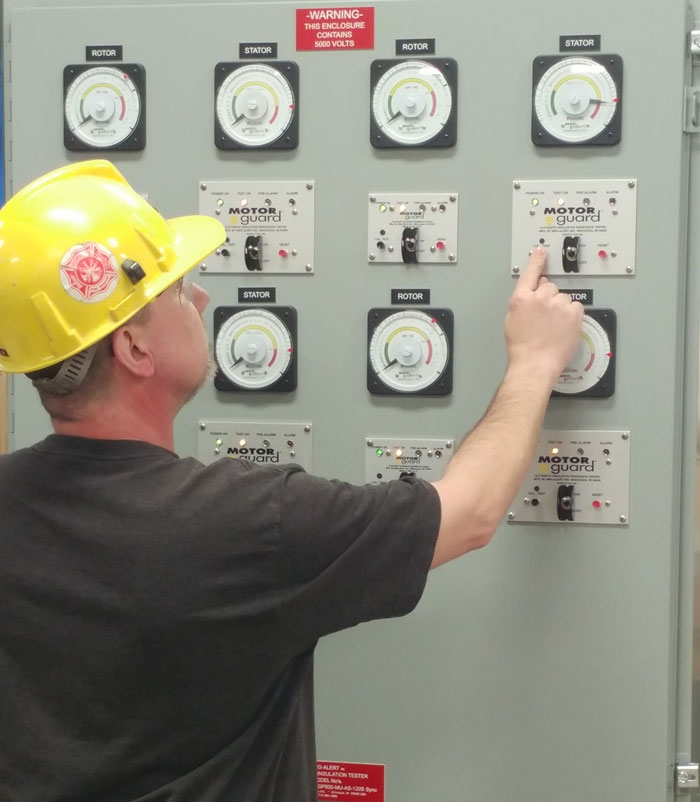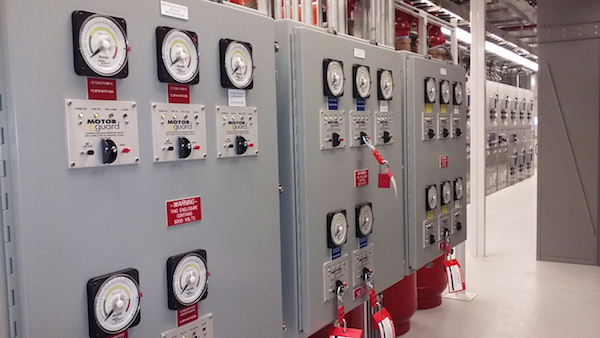
Features
Maintenance & Reliability
Paper
Pulp
Continuous insulation resistance testing for critical motors
Constant monitoring of critical motors while de-energized can prevent failures on startup and reduce unscheduled downtime
July 30, 2019 By Jeff Elliott
 A technician checks a Meg-Alert panel.
A technician checks a Meg-Alert panel. For decades, pulp and paper plant personnel have performed insulation resistance tests with handheld megohmmeters to prevent motor failures that can lead to unplanned shutdowns and re-winding repairs.
These manual tests only provide a snapshot of motor health. Between tests, even in a matter of only a few days, motor windings and cables that are exposed to moisture, chemicals, contaminants or vibration can become compromised and fail at startup.
Portable megohmmeters also require electrical technicians to manually disconnect the equipment cables and connect the test leads on potentially energized or damaged equipment to perform the manual testing. The manual tests expose technicians to potential arc flashes when they access the cabinet.
Pulp and paper plants can instead employ continuous megohm testing and monitoring of insulation resistance, which initiates the moment the motor is off until it is re-started again. Permanently installed automatic testing devices allow for “hands-off” monitoring without having to access cabinets – keeping technicians out of harm’s way.
Armed with real-time information from continuous monitoring, maintenance personnel can take corrective actions ahead of time to avoid a failure that would interrupt production or incur repair fees for rewinding.
Motor protection at pulp and paper plants
Thousands of motors can be used in typical pulp and paper plants, with about a third of them being critical.
Critical motors are those that could significantly impair the ability to safely meet business objectives or affect production levels if unexpectedly offline. Such motors can range from feedwater pumps and forced draft fan motors for boilers to water pumps and paper machine pumps. Typical paper mills have 3,000 to 4,000 HP motors for boiler feedwater pumps or paper machine fan pumps to spread the pulp out. Critical motors can be as large as 15,000 HP for some boiler feedwater pumps.
“We have about 3,800 motors in our plant, such as boiler feedwater pumps and boiler fans, paper machine fan pumps, and mill water supply pumps,” says Tim Forrester, maintenance manager of electric power distribution for a large paper mill in the southeastern United States, which is part of a major global pulp and paper manufacturer. “Quite a few of these motors are critical.”
The paper mill currently produces converting materials, bristols such as file folders, fluff pulp for hygiene products, and specialty grades such as wallboard tape and coating base.
Most pulp and paper plants maintain their motors through time-based preventative maintenance (PM) programs. Insulation resistance tests are typically scheduled on a semi-annual basis, or at the start of annual overhauls or planned outages; however, given the reduction in personnel at most plants, it may even be less frequent. Based on the results of these tests, motors may be scheduled to be sent out to repair shops for reconditioning.
Despite PM programs, motors that are offline or are frequently cycled can be quickly compromised. “With the large number of motors in a typical paper mill, you are going to have failures,” says Forrester. “A paper mill would usually have about six to eight hours of downtime, costing about $6,000 an hour, plus critical motor repair costing from $75,000 to $100,000. Some large synchronous motors, however, can cost up to $1 million to replace.”
While pulp and paper plants attempt to keep an adequate supply of spare motors on hand, Forrester adds that if purchasing a new critical motor is required, it can typically take 16 to 20 weeks – or even six to nine months – of lead time before receipt of a large synchronous motors. “You really have to plan ahead to order a new motor from a manufacturer,” he says.
To avoid such scenarios, Forrester says that his paper mill’s policy requires that any motor shut down for four hours or more be tested by a megohmmeter before it is started.
“Here in the south, we have high humidity and as the motors cool off, they take in moisture. It does not take long for moisture to get into a motor and cause problems. So, the motor has to be tested before we start it,” he says.
One challenge that the paper mill found with manual megohmmeters is that the devices did not always provide the necessary consistency due to subjectivity between technicians. “Manual megohmmeter testing introduces a lot of room for human error because it is subject to the technician’s interpretation [which can vary],” says Forrester.
Another problem was that the devices could only provide spot-checking, which lacks accuracy as soon as environmental conditions, such as temperature or humidity, change.
The paper mill’s engineers decided to install a continuous testing and monitoring device from Meg-Alert on a critical standby pump that required the ability to start immediately, if needed.
“Ever since then we have successfully used the [automatic continuous] testing device on any medium-voltage motor application that is not continuously running,” says Forrester.
The unit is permanently installed inside the high-voltage compartment of the MCC or switchgear and directly connects to the motor or generator windings. The unit senses when the motor or generator is offline and then performs a continuous dielectric test on the winding insulation until the equipment is re-started.
The Meg-Alert unit functions by applying a non-destructive, current-limited, DC test voltage to the phase windings and then safely measures any leakage current through the insulation back to ground. The system uses DC test voltage levels of 500, 1,000, 2,500 or 5,000 volts that meet the IEEE, ABS, ANSI/NETA and ASTM International standards for proper testing voltage based on the operating voltage of the equipment.
The test does not cause any deterioration of the insulation and includes current limiting technology that protects personnel.

Multiple Meg-Alert panels for motors. Photo supplied
Hands-off monitoring
The continuous monitoring system also allows for a hands-off approach that does not require service technicians to access control cabinets to perform a manual insulation resistance test.
Instead, an analog meter outside on the control cabinet door shows the insulation resistance megohm readings in real time. The meter also visibly indicates good, fair and poor insulation levels through a “green, yellow, red” colour scheme. When predetermined insulation resistance set point levels are reached, indicator lights will turn on to signal an alarm condition and automatic notifications can be sent out to the monitoring network.
Continuous monitoring can also show if the heaters used to maintain thermal temperatures and prevent condensation are working properly. Most motors use heaters to maintain the temperature inside the motor so it does not vary drastically from operating temperature or ambient temperatures outside the unit. If it goes below the dew point, the motor will start picking up condensation while offline.
However, if these heaters fail to operate properly or the circuit breaker is tripped, plant personnel may not be aware of it until the motor fails on startup. Although these motor heaters are checked regularly, critical motors can remain unprotected for weeks or even months.
Preventing arc flashes
According to Forrester, enhancing employee safety and preventing potential harm from arc flash was another key factor behind the decision to install the continuous insulation resistance testing and monitoring devices.
Arc flashes are an electric discharge that travels through the air between conductors or from a conductor to a ground. The flash is immediate and can produce temperatures four times that of the surface of the sun. The intense heat also causes a sudden expansion of air, which results in a blast wave that can throw workers across rooms and knock them off ladders.
Arc flash injuries include third degree burns, blindness, hearing loss, nerve damage, cardiac arrest and death.
Among the potential causes of an arc flash listed by NFPA 70E includes “improper use of test equipment.”
Although de-energizing equipment before testing and wearing appropriate personal protective equipment (PPE) is recommended, an ideal solution is to eliminate the need to access control cabinets to perform insulation resistance tests.
According to Forrester, at least four other mills contacted him regarding use of the continuous hands-off insulation resistance testing devices, and their popularity is growing at all their other pulp and paper mills.
“We have basically made these units standard at our mill, and they really should be an industry standard practice for any non-continuous medium voltage motor, or any critical NEMA motor,” he says.
Jeff Elliott is a Torrance, Calif.-based technical writer. He has researched and written about industrial technologies and issues for the past 20 years.
Print this page